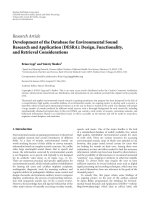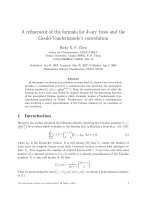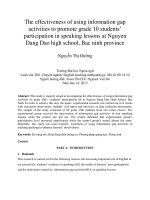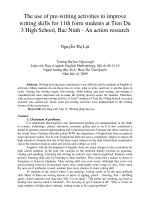The Big Book of Brain-Building Games Fun Activities to Stimulate the Brain for Better Learning, Communication and Teamwork (Big Book Series)
Bạn đang xem bản rút gọn của tài liệu. Xem và tải ngay bản đầy đủ của tài liệu tại đây (2.67 MB, 241 trang )
The
big book
brain
building
games
of
Fun Activities to Stimulate the Brain—for Better Group
Learning, Communication, and Understanding
Edward E. Scannell & Carol A. Burnett
New York Chicago San Francisco Lisbon London Madrid Mexico City
Milan New Delhi San Juan Seoul Singapore Sydney Toronto
Copyright © 2010 by The McGraw-Hill Companies, Inc. All rights reserved. Except as permitted under the United States Copyright
Act of 1976, no part of this publication may be reproduced or distributed in any form or by any means, or stored in a database or
retrieval system, without the prior written permission of the publisher.
ISBN: 978-0-07-163690-2
MHID: 0-07-163690-0
The material in this eBook also appears in the print version of this title: ISBN: 978-0-07-163522-6, MHID: 0-07-163522-X.
All trademarks are trademarks of their respective owners. Rather than put a trademark symbol after every occurrence of a trademarked
name, we use names in an editorial fashion only, and to the benefit of the trademark owner, with no intention of infringement of the
trademark. Where such designations appear in this book, they have been printed with initial caps.
McGraw-Hill eBooks are available at special quantity discounts to use as premiums and sales promotions, or for use in corporate training programs. To contact a representative please e-mail us at
Interior design by Think Book Works
Illustrations by Ryan Allen (www.ryanallen.com)
TERMS OF USE
This is a copyrighted work and The McGraw-Hill Companies, Inc. (“McGraw-Hill”) and its licensors reserve all rights in and to the
work. Use of this work is subject to these terms. Except as permitted under the Copyright Act of 1976 and the right to store and retrieve
one copy of the work, you may not decompile, disassemble, reverse engineer, reproduce, modify, create derivative works based upon,
transmit, distribute, disseminate, sell, publish or sublicense the work or any part of it without McGraw-Hill’s prior consent. You may
use the work for your own noncommercial and personal use; any other use of the work is strictly prohibited. Your right to use the work
may be terminated if you fail to comply with these terms.
THE WORK IS PROVIDED “AS IS.” McGRAW-HILL AND ITS LICENSORS MAKE NO GUARANTEES OR WARRANTIES AS
TO THE ACCURACY, ADEQUACY OR COMPLETENESS OF OR RESULTS TO BE OBTAINED FROM USING THE WORK,
INCLUDING ANY INFORMATION THAT CAN BE ACCESSED THROUGH THE WORK VIA HYPERLINK OR OTHERWISE,
AND EXPRESSLY DISCLAIM ANY WARRANTY, EXPRESS OR IMPLIED, INCLUDING BUT NOT LIMITED TO IMPLIED
WARRANTIES OF MERCHANTABILITY OR FITNESS FOR A PARTICULAR PURPOSE. McGraw-Hill and its licensors do not
warrant or guarantee that the functions contained in the work will meet your requirements or that its operation will be uninterrupted or
error free. Neither McGraw-Hill nor its licensors shall be liable to you or anyone else for any inaccuracy, error or omission, regardless
of cause, in the work or for any damages resulting therefrom. McGraw-Hill has no responsibility for the content of any information
accessed through the work. Under no circumstances shall McGraw-Hill and/or its licensors be liable for any indirect, incidental, special, punitive, consequential or similar damages that result from the use of or inability to use the work, even if any of them has been
advised of the possibility of such damages. This limitation of liability shall apply to any claim or cause whatsoever whether such claim
or cause arises in contract, tort or otherwise.
Contents
Acknowledgments
vii
Introduction: Games and Brains
Chapter 1
1
The Use of Games and Activities
in the World of Meetings
5
Let’s Look at Meetings
8
Time-Tested Tips for Better Meetings
8
Characteristics of Games and Activities
Suggestions for the Use of Games
Some Caveats
11
12
13
Games: Brain Teaser #1
15
Brainstorming
19
Creative People I Have Known
21
Six Thinking Hats (Group Perspective)
23
Six Thinking Hats (Individual Perspective)
27
Who’s on First?
31
Chapter 2
Brain “Very” Basics:
What Does It Look Like?
Basic Structure of the Brain
37
40
Left Brain–Right Brain Specialization
Games: Disney’s Four Cs of Creativity
All in the Family
51
Wanna Go for a Ride?
55
Take a Letter
57
One Word at a Time
59
Stand Up–Sit Down
61
43
49
iii
3
Brain Myths: Separating Fact
from Fiction
63
We Use Only 10 Percent of Our Brain
65
Some People Are Left-Brained; Some People Are
Right-Brained
66
Multitasking Saves Time
67
Drinking Alcohol Kills Brain Cells
68
You Can’t Grow New Brain Cells
69
Fact or Fiction?
70
Games: Brain Teaser #2
71
You Can’t Teach an Old Dog . . .
IQ vs. EQ
77
Right Brain, Left Brain?
79
What If?
81
The Dead Moose Society
83
4
May I Have Your Attention! Make the
Move from Attention to Memory
87
Models and Theories of Attention
90
Improving and Enhancing Attention
Games: Brain Teaser #3
95
Just Leave Me Alone
99
The Alphabet Game
101
The Official Stand-Up Person
5
Memory Retrieval
CONTENTS
92
103
Where Did I Put My Keys?
Help Your Brain Capture and
Store Information
105
The Memory Process
iv
75
107
110
Tip of the Tongue
Use It or Lose It!
111
112
Tips for Promoting Memory Retention
113
Games: Are You Smarter than a Ten-Year-Old?
I Can Dream, Can’t I?
119
Hi, There—Next! Part 1
121
Hi, There—Next! Part 2
123
Thanks for the Memories
125
When I Was a Kid . . .
131
6
117
Adult Learning: Help Your Brain
Adapt to Changing Situations
133
Effective Meetings
136
Theories of Adult Learning
Laws of Adult Learning
137
140
Generational Learning Styles
Ready, Set, Action
143
145
Games: Sooo, Howyadune? (Verbal Feedback
Version)
147
Sooo, Howyadune? (Visual Feedback
Version)
149
I Wish, I Wish
153
The Law of Effect
155
Actions Speak Louder than Words
157
Instant Experts
159
Dealing with Change
161
7
He Said, She Said: Explore Gender
Differences in Learning
163
Structural Differences
166
Functional Differences
167
CONTENTS
v
Games: Brain Teaser #4
175
Male-Female Brains
179
Male-Female Perceptions
181
Circle of Inclusion
183
My, How You’ve Changed!
185
Made to Stick
187
Chapter 8
Full Brain Fitness: Enhance and
Enrich Brain Function
191
Gifts to Give Your Brain
Brain Aerobics
194
203
Games: Mind Mapping
205
Want to Be a Genius?
207
Stress-Stress-Stress!
213
The Psychology of Change
215
Take a Card, Any Card
217
Communication Styles
219
Top of the Morning
225
Bibliography
vi
CONTENTS
227
Acknowledgments
Since the first book in the Games Trainers Play series was published some
twenty-five years ago, overall sales of that book and subsequent series
(More Games and The Big Book) have exceeded a million copies. With
this new book, there are now twelve titles in that series. For this, we are
indebted to the thousands of friends and colleagues who have attended
workshops and seminars with such groups as the American Society for
Training and Development (ASTD), Meeting Professionals International
(MPI), and National Speakers Association (NSA), as well as other associations and corporate groups. Coupled with our HRD and HRM audiences
across the globe, from “Old” Athens to New Zealand, these audiences have
helped us field-test the activities and exercises contained in this book.
On a personal note, a huge debt of gratitude goes to my son and daughters—Mike, Mary, Karen, and Cathie—who have given me their support,
love, and encouragement and made their dad a very proud father indeed!
—Edward E. Scannell
I wish to express my sincere gratitude to the following people (and their
magnificent brains) whose friendship, leadership, and mentoring have
contributed directly, indirectly, and often unknowingly to this book: a special thank you to Bob Lewis, Michael Young, Rob Till, Joe Krokrowoiak, Ed
Starr, Mary Helen Albrecht, Bonnie Buell, and to my precious friend Nancy
Richbart; to all my students and learners from the United States, Canada,
and Spain who have in turn assisted me in the learning process; thanks to
my wise, compassionate, and loving daughters, Shannon and Beth, who
vii
have always challenged my brain, warmed my heart, and served as my
cheerleaders; to my loving and supportive siblings, Chuck, Fran, Bev, Chris,
and Steve, who appreciate and embrace the concept of “safety in numbers,”
thank you for your lifelong encouragement; to all the dedicated brain scientists, researchers, and specialists who have and continue to devotingly
utilize their brains in an effort to help the rest of us understand and care
for ours—thank you, all.
—Carol A. Burnett
Note: Carol and I would both like to give special thanks to Mary Scannell,
who was helpful in assisting us with layout, proofreading, and overall
assistance; Colleen Fellin, who researched the hundreds of references for
us and helped compile the bibliography; and Ryan Allen, whose creativity
and ingenuity you will see sprinkled throughout these pages. Thanks also
go to Dr. Joanne Sujansky whose encouragement kept us going. Finally,
a special note of thanks to Emily Carlton, our editor, and Charles Fisher,
senior project editor, whose detail to attention made the final manuscript
“ready to roll.” We thank you for all your assistance!
viii
ACKNOWLEDGMENTS
Introduction
Games and Brains
You can discover more about a person in an hour of play than in a year of
discussion.
—Plato
Research has proven time and again that games, activities, and exercises add spark and excitement to training sessions and help participants
achieve dramatically better learning results. The
real learning, of course, is not in the game itself
but in the process of the activity.
Experienced human resource development
professionals, trainers, and meeting planners
know full well the value of engaging their audiences in active participation and have used this
learning methodology in some of the following ways:
•
•
•
•
•
games to develop leadership ability and build self-confidence
brain teasers that enhance problem-solving skills and boost creativity
exercises that teach people to be cooperative and enthusiastic team
players
games that dramatically improve communications skills—from speaking in public to knowing how to listen
icebreakers guaranteed to grab and hold any group’s attention
1
This book offers a component never before included in a volume filled
with such games, puzzles, and exercises. Each chapter introduces state-ofthe-art (but easy-to-understand) summaries of specific recent biological,
physiological, cognitive, and behavioral research on the brain—and how
that research relates to the learning process. The activities that follow each
of the chapters will demonstrate, reinforce, and validate the ever-changing
plasticity of the brain.
So, why combine brains and games? Recently, the media seem to be
infatuated with the brain—how the brain functions, how it ages, and how
to nurture, nourish, and strengthen the brain.
Until recently, brain research was limited to exploring how diseased,
dysfunctional, or injured brains functioned. Researchers didn’t have noninvasive, safe techniques to delve into the inner workings of the healthy
brain (beneath the skull) until the mid-1980s. But aided by cutting-edge
technologies, today’s neuroscientists have propelled us forward in our
approach to thinking and learning about our brains.
The Brain Fitness Revolution is here. This exciting frontier signifies a
new era—a brain-new world.
How to Use This Book
Happily, you will find that most training audiences today not only enjoy
taking part in these experiential activities but also expect them to be an
integral part of their lifelong learning process.
These types of exercises have multiple uses. First and foremost, they
are an absolute necessity as climate setters. The importance of first
impressions is well documented, and it is imperative that some kind of
get-acquainted exercise be used early in any workshop, or even during the
keynote presentation. This will set the tone for the rest of the event. So
make certain that those first few minutes include some kind of welcoming
activity. This could be as simple as a “meet and greet,” a brief way of meeting new friends, or a longer networking game. In any event, allow ample
time for this warm-up at the beginning of your sessions.
If it’s a workshop you’re running, you’ll want to incorporate additional
games throughout your program. These can take the form of motivating
2
THE BIG BOOK OF BRAIN-BUILDING GAMES
and team-building exercises, which create a fertile atmosphere for handling change, creativity, and problem-solving methods.
You’ll want to become acquainted with the contents of this book well
before utilizing the games in any training session, as it will give you an
excellent working knowledge of how the brain functions. In so doing, you’ll
be better equipped to enhance the learning environment by expanding
your learners’ experience and development through innovative brainbased approaches.
Suggestions for Using Games
Before selecting an activity for your event or program, make sure you have
identified the general (or specific) objective or purpose for conducting
your game. Become completely familiar with the game and even try it out
with some coworkers to make sure you are well prepared to use it in your
programs.
Even though all the games in this book have been used successfully
with a variety of groups—from entry-level hires to CEOs—it is imperative
you establish your own comfort zones in advance.
When you introduce a game, give your attendees a brief explanation of
what they’ll be experiencing and clearly describe the objectives. Although
you may still encounter an occasional indifferent attitude on the part of
an attendee, experience has shown that once these individuals understand that it’s just not a “game” but a proven way to strengthen and fortify the point you are making, they tend to become actively (and willingly)
involved.
While most of these activities require a relatively brief period of time to
complete, make sure you always allow sufficient time to debrief the activity and discuss the questions posed. Don’t be confined or constrained by
the suggested questions; rather, let the group continue their own discussions as needed and appropriate.
Also be aware, however, that this discussion time is not a “gripe session” or time to find axes to grind. As you wander among the groups during their respective discussions, listen carefully to ensure they’re on target
with their comments and focusing their discussions on the questions at
INTRODUCTION
3
hand. When leading these discussions, be aware of all your participants
and try to get everyone involved. You may encounter an occasional “knowit-all” who thinks he or she has all the answers. While it is good to get this
person’s input, don’t let any one individual monopolize the conversations.
If you’re posting the group’s responses on a flip chart, let that person do the
recording for the group.
On the other hand, if you find someone who seems reticent to offer
any comments, make it a point to ask that person a rather easy question.
Merely letting him or her give a correct response may supply the confidence needed to take a more active role.
Selecting the Proper Game
As you read through this book, you will find a selection of games/activities at the end of each chapter. While these games may address specific
aspects of brain function, such as male versus female brains or the differences between left and right brains, many of them are appropriate for
other uses as well.
For example, the activities on creativity are multipurpose and can easily be used in other types of programs. The same is true for some climatesetting activities and those that emphasize strategies for dealing with
change.
While all of these games are completely appropriate for small-group
workshops (up to 50 participants), many are also usable for large-group
keynotes. However, since most keynotes run an hour or less, if this is the
nature of your use, select an activity that can be conducted in just a few
minutes. The main challenge in using games in keynotes is not getting
people to talk—it’s how to get them to stop talking when time is up!
This book can be an excellent resource for you in your role as meeting
planner, speaker, trainer, or manager.
So let’s get to it!
4
THE BIG BOOK OF BRAIN-BUILDING GAMES
1
s
e
m
a
e
fG
h
o
t
e
s
n
i
U
s
e
e
i
h
t
T
i
v
i
s
t
g
c
n
A
i
t
d
e
e
an
M
f
o
d
l
r
o
W
ir
k at the
o
lo
le
p
nd
t peo
k at it a
o
ept tha
c
lo
c
y
a
e
I
h
,
en t
cture
te is wh
ive a le
a
r
g
I
le
o
n
t
e
t
no
Wh
.
hat I do
w
t
u
topped
b
s
,
it
s
if
e
h
t
c
wat
rd
nd ou
el Acha
ear to fi
c
r
ir
a
e
M
h
t
—
to
raise it
5
6
THE BIG BOOK OF BRAIN-BUILDING GAMES
Chapter Highlights
In this opening chapter, you will learn several ways to make your meetings
more effective. You’ll also discover some of the dos and don’ts for using
games in meetings.
Ask anyone who has been around the meetings or training arena for a
while, and they’ll likely all agree on two things when it comes to experiential learning:
1. Today’s meeting and conference attendees want to be entertained as well as be informed. In short, they want proof that
learning can be fun. This is not to say that all learning must be “fun
and games,” but given the admittedly short attention span of most
audiences, it is clear that we must engage and involve our attendees
as much as possible. In fact, recent brain research clearly indicates
that if we don’t in some way engage participants every five to seven
minutes, we’ll lose them. Additional findings in this area tell us that
when we physically move around, the body produces chemicals that
have a positive effect on our thinking. Finally, according to the Center
for Accelerated Learning, “people who learn in a fun, active way learn
faster and remember more.” This study also suggested that we can
reduce training time by as much as 60 percent owing to this faster
absorption.
2. Learning is not a spectator sport! Let’s think about that for a
moment. While we, of course, believe that the content and material
we bring to our audiences is relevant, timely, and useful, we’re also
suggesting that the more they can discuss, debate, and deliberate
this information, the more it will resonate with them. It is also true
that we often learn as much, if not more, from our colleagues during
break times, hallway conversations, and other casual moments we
spend conversing with other participants. In other words, the personal
experiences we often share with fellow attendees are also a learning
activity.
THE USE OF GAMES AND ACTIVITIES IN THE WORLD OF MEETINGS
7
Let’s Look at Meetings
Someone once quipped that if everyone attending a meeting at this very
moment were all laid end to end,
they’d probably be a lot more comfortable! This would be funny if it weren’t
so often true. But one look at your own
corporate or association meetings is all
you need to know he had a point.
Every day literally millions of meetings are held, yet many—perhaps
most—fail to hit their mark. Ask any experienced meeting professional,
and each one will stress the importance of having goals and objectives for
any meeting. Check your own organization’s track record, however, and
you’ll see a different story. For example, an association may have its annual
conference each year. And why? you ask. “Well, because we always have
our annual meeting every year.” Sound a bit redundant?
In today’s marketplace, with an uncertain economy and continued scrutiny on the entire world of meetings, we’d best be prepared for some serious
questions—perhaps even from our superiors, stakeholders, and colleagues.
So, with this brief background, let’s look at some tested tips and questions that must be addressed.
Time-Tested Tips for Better Meetings
These suggestions will help ensure that your meetings—from small-group
training workshops and seminars to multithousand-attendee conferences
or conventions—will all be productive and cost-effective.
Define Your Objectives
•
•
•
•
•
•
8
To introduce new information?
To announce a change?
To review or modify policies?
To solve a problem?
To motivate or reward?
To introduce a new product?
THE BIG BOOK OF BRAIN-BUILDING GAMES
Do you have a specific goal in mind that others are aware of? If not, why
not?
Target Your Outcomes
•
•
•
•
What will happen after the meeting is over?
What are the desired end results of this meeting?
How will you know if these end results are met?
How will your manager or the participants know if results are met?
In many associations, we have seen a strong trend whereby potential speakers and facilitators are required to identify, prior to speaking, three or four
solid takeaways or outcomes that their participants can expect to learn.
In the old days, an objective could be simply “to understand” or “to
appreciate” a certain concept; clearly, that language won’t cut it today.
Experienced meeting professionals are demanding these objectives in
action-oriented, behavioral terms, such as “to identify the five steps in
closing a sale” or to “demonstrate at least three ways to increase customer
satisfaction.”
Define Your Participants
•
•
•
•
•
Who will be coming to your meeting? Are these the appropriate
people?
Do they have sufficient experience or background to be able to contribute to the meeting’s goals?
Do you know what their expectations are? Might there be some hidden
agenda items on their minds?
Can you be sure they’ll be listening to you, rather than texting or using
their BlackBerrys the whole time?
Are they there because they really want to be there—or is it a case of
a captive audience (i.e., “I’m here because my boss told me I had to
come”)?
Determine the Agenda
•
•
What are the topics that should be covered?
For small group meetings, do you have a prepared agenda?
THE USE OF GAMES AND ACTIVITIES IN THE WORLD OF MEETINGS
9
•
•
Will your participants have the agenda in advance?
Will attendees have an opportunity to make changes or suggestions to
the agenda? Can you be flexible enough to allow them to do so?
Consider Timing
•
•
•
•
How long will the meeting last?
What time of day is it scheduled for?
Has sufficient time been allowed to adequately cover all the necessary
items? If not, when will the next meeting be scheduled?
What day(s) of the week? For example, Mondays or Fridays are often
not the best days for meetings, because people’s energy levels are best
in the middle of the week. Meetings are usually most successful when
held on Tuesdays or Wednesdays.
Define Roles
•
•
•
What roles and responsibilities will the attendees have?
Will you need a facilitator? Timekeeper? Scribe? Parliamentarian?
Are the attendees comfortable in their assignments? Have they volunteered themselves, or have they been volunteered by a third party?
Decide on Process or Method
•
•
•
Do the items on the agenda call for decisions, or are they merely
informational?
If your role is that of a facilitator, have you ensured that everyone will
have a chance to participate?
If yours is a training or speaking assignment, have you allowed time
for interaction or other ways of engaging or involving the group?
Identify Action Steps
•
•
•
As the meeting closes, have you identified the action steps the group
has agreed on?
Does everyone have marching orders?
Have you made a “to do” list to ensure that nothing was left undone?
Nothing is quite as perplexing or frustrating to a group as leaving a meeting with no clear idea of what is going to happen next. The attendees are
likely to feel their time has been wasted.
10
THE BIG BOOK OF BRAIN-BUILDING GAMES
Evaluate the Meeting
•
•
After the meeting, have you informed participants and other relevant
parties of the actions and decisions made?
In retrospect, were the right decisions made? If not, what needs to be
done next?
Certainly a formal evaluation or critique is an expected part of any training program, but even in small-group get-togethers some type of follow-up
is of paramount importance.
Now then . . .
Characteristics of Games and Activities
With that brief look at the world of meetings under our belts, let’s turn our
attention to some traits of these learning activities. Essentially, a game or
exercise can be used to support and enhance the learning point or content
you are presenting. Whether you’re offering cognitive, affective, or psychomotor types of learning, all three can be reinforced through the use of
audience involvement activities.
It is important to remember, of course, that the game is not the focal
point of the learning—it is used to embellish and support the learning. In
short, don’t let the adage of “the tail wagging the dog” come into play.
In this book, you will find these characteristics in all the activities
presented:
•
•
•
Brief: In most cases, these activities range in duration from a few minutes to 20 or 30. While we all have seen some activities that take an hour
or longer, we strongly believe that the shorter, the better. This is merely
to suggest that people want content, and while games are, of course, fun,
they must take a secondary role to the information being presented.
Low risk: All of the exercises presented here have been used with
groups around the globe. All have been field-tested with a variety of
groups, from entry level to executive levels, and given the proper time
for processing, you can be assured they will work for you as well.
Adaptable: Regardless of the groups with whom you are working, use
the games as presented here or, better yet, tailor them more to the particular audience.
THE USE OF GAMES AND ACTIVITIES IN THE WORLD OF MEETINGS
11
•
•
Inexpensive: As you will note, most of the games require very little
if any other resources. Even with those that suggest handouts, in the
spirit of “going green,” these can easily be transferred to PowerPoint
slides.
Targeted: Most games will have a specific objective or learning point.
However, you may find other tangential uses for them as well. If so, so
much the better. Read through the selected exercises and make your
judgment accordingly.
Suggestions for the Use of Games
Recent brain research shows the importance of both mental and physical
activity to enhance memory and the learning process. So keep these points
in mind as you plan and orchestrate your next program.
In summary, consider these suggestions for optimal results with the use
of these games:
•
•
•
12
Be prepared. It’s been said that the three most important parts of
any presentation are (1) preparation, (2) preparation, and, of course, (3)
preparation! It’s also been joked that “preparation makes up for a lack
of talent.” We wouldn’t say so, of course, but the underlying point holds
up: plan and practice the game with coworkers, family, or friends.
This will give you a solid comfort zone and better prepare you for any
situation.
Be brief. As already stated, make your point and move on. And
remember, the games are always an added benefit, a fun way of
imparting information. Don’t let them be the main course. Certainly,
a two- or three-minute get-acquainted activity at the beginning of a
small-group get-together is a must (especially if the attendees don’t
know one another), but don’t use too many too early. Here are a few
rules of thumb: In a 45-minute keynote, use maybe two or three games
at most. In a half-day or longer workshop, sprinkle several throughout
the day. Sometimes all that’s needed is a quick break to stand up and
move around.
Be purposeful. The old saying “You can’t get lost if you don’t know
where you’re going” may well be true, but it has no value in today’s
THE BIG BOOK OF BRAIN-BUILDING GAMES
•
•
workplace. Each of the games herein has a specific goal or objective,
clearly stated below the game’s title. Certainly, you may find additional
purposes as well. This is fine, but always make certain that your participants know your precise reason or objective for any game or activity. Always allow sufficient time to debrief the activity. This processing
time is most valuable in that it allows all your participants to better
understand the goal and how that exercise added to the point you
were making.
Seek participation. This may sound trite, but if you want the involvement of the group, you’d best demonstrate that you can have fun too.
Acknowledge openly that you may not have all the answers but are
honestly soliciting attendees’ assistance and participation in making
this particular program all the more viable and rewarding for them.
Games exist to help facilitate learning, and for many people learning
is a self-developmental process. Moreover, given the nature of today’s
audiences, their attention won’t necessarily be on their speaker or
facilitator 100 percent of the time. Clearly no one wants to be “talked
at” today, and by getting them involved, you’re already on your way to
a more productive and enjoyable workshop.
Be playful. This doesn’t mean act like a stand-up comedian, but
rather that it’s OK to have some fun in your sessions. By letting people
know this at the beginning of your program, you’re already well on
the way to establishing the rapport so critical with any group. Keep in
mind, of course, that games have a place in most—but not necessarily all—programs. There are times when overt humor would be clearly
inappropriate. But that doesn’t mean that you still can’t have audience
involvement along the way.
Some Caveats
While our bias for group participation is a serious one, we’d be remiss if we
didn’t mention just a few things to watch out for along the way.
•
Don’t be gimmicky. If you’re seen as the “class clown,” you’re in the
wrong business! And if your program comes off as nothing but fun and
games, then you are really in the wrong business. As you go through
THE USE OF GAMES AND ACTIVITIES IN THE WORLD OF MEETINGS
13
•
•
•
this book, you will see dozens of activities that are fun and enjoyable; but make certain that you always emphasize the objective and
learning points. The last thing you want is to have your participants
walk away with these questions unanswered: What was I supposed to
learn? Was that time really worth the effort? What was his point? Why
did she spend so much time playing that game?
Don’t overdo it. As previously mentioned, the game is always an
appetizer or dessert, but not the main part of the meal. Use the game
at—and only at—the appropriate time. And remember, it doesn’t
always have to be a playful game. The activity could take many forms,
as long as it’s relevant and ties into the point being made.
Don’t use games to kill time. Time is a more precious commodity
now than ever, and your attendees’ time is far too valuable to waste.
Choose your activity wisely—if a point can be made with a 10-minute
exercise, why spend 30 minutes achieving the same goal?
Avoid the “hardening” of the categories. These presentation topics
tend to be fairly fluid. Be innovative; be creative. Find alternative uses
for the games presented. Add, delete, or change these items as you see
fit. By mixing it up, you will ensure that your audiences are with you
all the way!
That’s it. Ladies and gentlemen, start your engines!
14
THE BIG BOOK OF BRAIN-BUILDING GAMES
Brain Teaser #1
OBJECTIVES
• To do something “just for fun”
• To practice creativity or creative problem solving
Materials
Copy of the Brain Teaser #1 handout (provided)
for each attendee
Time
5 to 15 minutes
Procedure
Give each audience member a copy of the
handout. Explain that each of the 16 frames or
boxes in the quiz suggests a well-known slogan,
phrase, or saying and that the task is to decipher
the hidden message in each box. To get the ball rolling and ensure that
the group has a clear understanding of how the quiz works, provide the
answer to one of the frames.
Allow participants two to three minutes to do the quiz individually. Then
suggest that they pair up with a partner and see how many more frames
they can solve together. Allow another two to three minutes. Then, starting with frame #1, begin soliciting answers from the group. If a response is
fairly close to the “right” answer (if they’ve got the idea but perhaps a word
wrong), simply paraphrase the answer to make it the correct one.
Discussion Questions
1.
2.
3.
4.
How many frames were you able to solve correctly on your own?
How many more did you solve when you worked with others?
When working with partners, did you come up with alternate answers?
Are you able to create some of these brain teasers yourself? Try one now. Is it
easier solving a brain teaser or creating a brain teaser?
THE USE OF GAMES AND ACTIVITIES IN THE WORLD OF MEETINGS
15
H A N DO UT
Brain Teaser #1
Decipher the hidden meaning of each box. Each of these describes a well-known
saying or slogan.
1.
2.
DEEF
5.
3.
AZILAKWI
L
O
A
D
8.
CH
R
APPLE
Doing Learn
7.
6.
GAIN
GAIN
4.
ATTE
TORIAL
TORIAL
GAIN
9.
10. LONELY
TREHIDASURE
13.
BJAOCKX
16
11.
S
14.
H
12.
E
15.
AgNNIVERSARY
THE BIG BOOK OF BRAIN-BUILDING GAMES
E
T
BA NK
16.
BUR
CONDU









